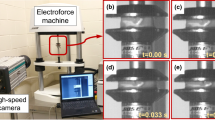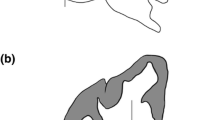Abstract
Understanding the viscoelastic behavior of pediatric brain tissue is critical to interpret how external mechanical forces affect head injury in children. However, knowledge of the viscoelastic properties of pediatric brain tissue is limited, and this reduces the biofidelity of developed numeric simulations of the pediatric head in analysis of brain injury. Thus, it is essential to characterize the viscoelastic behavior of pediatric brain tissue in various loading conditions and to identify constitutive models. In this study, the pediatric porcine brain tissue was investigated in compression with determine the viscoelasticity under small and large strain, respectively. A range of frequencies between 0.1 and 40 Hz was applied to determine frequency-dependent viscoelastic behavior via dynamic mechanical analysis, while brain samples were divided into three strain rate groups of 0.01/s, 1/s and 10/s for compression up to 0.3 strain level and stress relaxation to obtain time-dependent viscoelastic properties. At frequencies above 20 Hz, the storage modulus did not increase, while the loss modulus increased continuously. With strain rate increasing from 0.01/s to 10/s, the mean stress at 0.1, 0.2 and 0.3 strain increased to approximate 6.8, 5.6 and 4.4 times, respectively. The brain compressive response was sensitive to strain rate and frequency. The characterization of brain tissue will be valuable for development of head protection systems and prediction of brain injury.







Similar content being viewed by others
References
Araki T, Yokota H, Morita A (2017) Pediatric traumatic brain injury: characteristic features, diagnosis, and management. Neurol Med Chir (tokyo) 57:82–93. https://doi.org/10.2176/nmc.ra.2016-0191
Bar-Kochba E, Scimone MT, Estrada JB, Franck C (2016) Strain and rate-dependent neuronal injury in a 3D in vitro compression model of traumatic brain injury. Sci Rep 6:30550. https://doi.org/10.1038/srep30550
Barnes SC, Lawless BM, Shepherd DET, Espino DM, Bicknell GR, Bryan RT (2016) Viscoelastic properties of human bladder tumours. J Mech Behav Biomed Mater 61:250–257. https://doi.org/10.1016/j.jmbbm.2016.03.012
Bilston LE, Liu ZZ, Phan-Thien N (2001) Large strain behavior of brain tissue in shear: some experimental data and differential constitutive model. Biorheology 38:335–345
Budday S, Nay R, de Rooij R, Steinmann P, Wyrobek T, Ovaert TC, Kuhl E (2015) Mechanical properties of gray and white matter brain tissue by indentation. J Mech Behav Biomed Mater 46:318–330. https://doi.org/10.1016/j.jmbbm.2015.02.024
Budday S, Sommer G, Birkl C, Langkammer C, Haybaeck J, Kohnert J, Bauer M, Paulsen F, Steinmann P, Kuhl E, Holzapfel GA (2017a) Mechanical characterization of human brain tissue. Acta Biomater 48:319–340. https://doi.org/10.1016/j.actbio.2016.10.036
Budday S, Sommer G, Holzapfel GA, Steinmann P, Kuhl E (2017b) Viscoelastic parameter identification of human brain tissue. J Mech Behav Biomed Mater 74:463–476. https://doi.org/10.1016/j.jmbbm.2017.07.014
Burton H, Freij J, Espino DM (2017) Dynamic viscoelasticity and surface properties of porcine left anterior descending coronary arteries. Cardiovasc Eng Technol 8:41–56. https://doi.org/10.1007/s13239-016-0288-4
Chan RW, Titze IR (2003) Effect of postmortem changes and freezing on the viscoelastic properties of vocal fold tissues. Ann Biomed Eng 31:482–491. https://doi.org/10.1114/1.1561287
Chatelin S, Vappou J, Roth S, Raul JS, Willinger R (2012) Towards child versus adult brain mechanical properties. J Mech Behav Biomed Mater 6:166–173. https://doi.org/10.1016/j.jmbbm.2011.09.013
Chen Y, Qiu S, Wang C, Li X, Tang Y, Feng Y (2020) Measurement of viscoelastic properties of injured mouse brain after controlled cortical impact. Biophys Rep 6:137–145. https://doi.org/10.1007/s41048-020-00110-1
Cheng S, Bilston LE (2007) Unconfined compression of white matter. J Biomech 40:117–124. https://doi.org/10.1016/j.jbiomech.2005.11.004
Cheng S, Clarke EC, Bilston LE (2009) The effects of preconditioning strain on measured tissue properties. J Biomech 42:1360–1362. https://doi.org/10.1016/j.jbiomech.2009.03.023
Darvish KK, Crandall JR (2001) Nonlinear viscoelastic effects in oscillatory shear deformation of brain tissue. Med Eng Phys 23:633–645. https://doi.org/10.1016/S1350-4533(01)00101-1
Dickerson JWT, Dobbing J, McCance RA (1967) Prenatal and postnatal growth and development of the central nervous system of the pig. Proc R Soc Lond B Biol Sci 166:384–395. https://doi.org/10.1098/rspb.1967.0002
Elkin BS, Ilankova A, Morrison B (2011) Dynamic, regional mechanical properties of the porcine brain: indentation in the coronal plane. J Biomech Eng-Trans Asme. https://doi.org/10.1115/1.4004494
Fan H, Jin X, Hu J, Yanga KH (2014) Age dependent material properties of infant and adolescent porcine brain. Presented at the WSU 75th Anniversary Symposium Injury Biomechanics, Prevention, Diagnosis & Treatment, Detroit, MI, USA
Feng Y, Okamoto RJ, Namani R, Genin GM, Bayly PV (2013) Measurements of mechanical anisotropy in brain tissue and implications for transversely isotropic material models of white matter. J Mech Behav Biomed Mater 23:117–132. https://doi.org/10.1016/j.jmbbm.2013.04.007
Forte AE, Gentleman SM, Dini D (2017) On the characterization of the heterogeneous mechanical response of human brain tissue. Biomech Model Mechanobiol 16:907–920. https://doi.org/10.1007/s10237-016-0860-8
Franklyn M, Peiris S, Huber C, Yang KH (2007) Pediatric material properties: a review of human child and animal surrogates. Crit Rev Biomed Eng 35:197–342. https://doi.org/10.1615/critrevbiomedeng.v35.i3-4.20
Hardman JM, Manoukian A (2002) Pathology of head trauma. Neuroimaging Clin N Am 12:175–187. https://doi.org/10.1016/S1052-5149(02)00009-6
Hon KL, Huang S, Poon WS, Cheung HM, Ip P, Zee B (2019) Mortality and morbidity of severe traumatic brain injuries; a pediatric intensive care unit experience over 15 years. Bull Emerg Trauma 7:256–262. https://doi.org/10.29252/beat-070308
Laksari K, Kurt M, Babaee H, Kleiven S, Camarillo D (2018) Mechanistic insights into human brain impact dynamics through modal analysis. Phys Rev Lett 120:138101
Laksari K, Wu LC, Kurt M, Kuo C, Camarillo DC (2015) Resonance of human brain under head acceleration. J R Soc Interface. https://doi.org/10.1098/rsif.2015.0331
Li W, Shepherd DET, Espino DM (2021a) Investigation of the compressive viscoelastic properties of brain tissue under time and frequency dependent loading conditions. Ann Biomed Eng. https://doi.org/10.1007/s10439-021-02866-0
Li W, Shepherd DET, Espino DM (2021b) Dynamic mechanical characterization and viscoelastic modeling of bovine brain tissue. J Mech Behav Biomed Mater 114:104204. https://doi.org/10.1016/j.jmbbm.2020.104204
Li W, Shepherd DET, Espino DM (2020a) Frequency dependent viscoelastic properties of porcine brain tissue. J Mech Behav Biomed Mater 102:103460. https://doi.org/10.1016/j.jmbbm.2019.103460
Li Z, Ji C, Li D, Luo R, Wang G, Jiang J (2020b) A comprehensive study on the mechanical properties of different regions of 8-week-old pediatric porcine brain under tension, shear, and compression at various strain rates. J Biomech 98:109380. https://doi.org/10.1016/j.jbiomech.2019.109380
Li ZG, Yang HF, Wang GL, Han XQ, Zhang SP (2019) Compressive properties and constitutive modeling of different regions of 8-week-old pediatric porcine brain under large strain and wide strain rates. J Mech Behav Biomed Mater 89:122–131. https://doi.org/10.1016/j.jmbbm.2018.09.010
MacManus DB, Pierrat B, Murphy JG, Gilchrist MD (2017) A viscoelastic analysis of the P56 mouse brain under large-deformation dynamic indentation. Acta Biomater 48:309–318. https://doi.org/10.1016/j.actbio.2016.10.029
Mahmood H, Shepherd DET, Espino DM (2018) Surface damage of bovine articular cartilage-off-bone: the effect of variations in underlying substrate and frequency. BMC Musculoskelet Disord 19:384. https://doi.org/10.1186/s12891-018-2305-2
Meaney DF, Smith DH (2011) Biomechanics of concussion. Clin Sports Med 30:19–vii. https://doi.org/10.1016/j.csm.2010.08.009
Mendizabal A, Aguinaga I, Sánchez E (2015) Characterisation and modelling of brain tissue for surgical simulation. J Mech Behav Biomed Mater 45:1–10. https://doi.org/10.1016/j.jmbbm.2015.01.016
Miller K, Chinzei K (1997) Constitutive modelling of brain tissue: experiment and theory. J Biomech 30:1115–1121
Nguyen R, Fiest KM, McChesney J, Kwon C-S, Jette N, Frolkis AD, Atta C, Mah S, Dhaliwal H, Reid A, Pringsheim T, Dykeman J, Gallagher C (2016) The international incidence of traumatic brain injury: a systematic review and meta-analysis. Can J Neurol Sci J Can Sci Neurol 43:774–785. https://doi.org/10.1017/cjn.2016.290
Prange MT (2002) Biomechanics of traumatic brain injury in the infant. University of Pennsylvania
Prange MT, Margulies SS (2002) Regional, directional, and age-dependent properties of the brain undergoing large deformation. J Biomech Eng-Trans Asme 124:244–252. https://doi.org/10.1115/1.1449907
Pujalte GG, Dekker TM, Abadin AA, Jethwa TE (2020) Signs and symptoms of concussion. Concussion Manag. Prim. Care Evid. Based Answ. Cases Quest, pp 19–30
Qian L, Zhao H, Guo Y, Li Y, Zhou M, Yang L, Wang Z, Sun Y (2018) Influence of strain rate on indentation response of porcine brain. J Mech Behav Biomed Mater 82:210–217. https://doi.org/10.1016/j.jmbbm.2018.03.031
Qiu S, Jiang W, Alam MS, Chen S, Lai C, Wang T, Li X, Liu J, Gao M, Tang Y, Li X, Zeng J, Feng Y (2020) Viscoelastic characterization of injured brain tissue after controlled cortical impact (CCI) using a mouse model. J Neurosci Methods 330:108463. https://doi.org/10.1016/j.jneumeth.2019.108463
Rashid B, Destrade M, Gilchrist MD (2014) Mechanical characterization of brain tissue in tension at dynamic strain rates. J Mech Behav Biomed Mater 33:43–54. https://doi.org/10.1016/j.jmbbm.2012.07.015
Rashid B, Destrade M, Gilchrist MD (2012) Mechanical characterization of brain tissue in compression at dynamic strain rates. J Mech Behav Biomed Mater 10:23–38. https://doi.org/10.1016/j.jmbbm.2012.01.022
Roth S, Raul J-S, Willinger R (2010) Finite element modelling of paediatric head impact: global validation against experimental data. Comput Methods Prog Biomed 99:25–33. https://doi.org/10.1016/j.cmpb.2009.10.004
Sahoo D, Deck C, Willinger R (2014) Development and validation of an advanced anisotropic visco-hyperelastic human brain FE model. J Mech Behav Biomed Mater 33:24–42. https://doi.org/10.1016/j.jmbbm.2013.08.022
Szarko M, Muldrew K, Bertram JEA (2010) Freeze-thaw treatment effects on the dynamic mechanical properties of articular cartilage. Bmc Musculoskelet Disord. https://doi.org/10.1186/1471-2474-11-231
Takhounts EG, Crandall JR, Darvish K (2003) On the importance of nonlinearity of brain tissue under large deformations. Stapp Car Crash J 47:79–92
Tamura A, Hayashi S, Watanabe I, Nagayama K, Matsumoto T (2007) Mechanical characterization of brain tissue in high-rate compression. J Biomech Sci Eng 2:115–126. https://doi.org/10.1299/jbse.2.115
Thibault KL, Margulies SS (1998) Age-dependent material properties of the porcine cerebrum: effect on pediatric inertial head injury criteria. J Biomech 31:1119–1126. https://doi.org/10.1016/S0021-9290(98)00122-5
Velardi F, Fraternali F, Angelillo M (2006) Anisotropic constitutive equations and experimental tensile behavior of brain tissue. Biomech Model Mechanobiol 5:53–61. https://doi.org/10.1007/s10237-005-0007-9
Wilcox AG, Buchan KG, Espino DM (2014) Frequency and diameter dependent viscoelastic properties of mitral valve chordae tendineae. J Mech Behav Biomed Mater 30:186–195. https://doi.org/10.1016/j.jmbbm.2013.11.013
Yan J-G, Zhang L, Agresti M, LoGiudice J, Sanger JR, Matloub HS, Havlik R (2015) Neural systemic impairment from whole-body vibration. J Neurosci Res 93:736–744. https://doi.org/10.1002/jnr.23536
Young L, Rule GT, Bocchieri RT, Walilko TJ, Burns JM, Ling G (2015) When physics meets biology: low and high-velocity penetration, blunt impact, and blast injuries to the brain. Front Neurol 6:89. https://doi.org/10.3389/fneur.2015.00089
Zhao H, Yin Z, Li K, Liao Z, Xiang H, Zhu F (2016) Mechanical characterization of immature porcine brainstem in tension at dynamic strain rates. Med Sci Monit Basic Res 22:6–13. https://doi.org/10.12659/MSMBR.896368
Acknowledgements
The authors would like to thank Lee Gauntlett from the Department of Mechanical Engineering, University of Birmingham for assistance in manufacturing of fixtures. This study was sponsored by the National Natural Science Foundation of China (Grant No. 12302417) and Shanghai Pujiang Program (23PJ1409200). The equipment used in this study was funded by Arthritis Research UK [H0671; now part of Versus Arthritis].
Author information
Authors and Affiliations
Contributions
WL: Conceptualization, Methodology, Investigation, Writing - original draft, Writing - review & editing, Visualization, Project administration. DET: Resources, Writing review & editing, Supervision, Funding acquisition. DME: Methodology, Writing - review & editing, Supervision, Project administration.
Corresponding author
Ethics declarations
Conflict of interest
The authors declare that they have no known competing financial interests or personal relationships that could have appeared to influence the work reported in this paper.
Additional information
Publisher's Note
Springer Nature remains neutral with regard to jurisdictional claims in published maps and institutional affiliations.
Rights and permissions
Springer Nature or its licensor (e.g. a society or other partner) holds exclusive rights to this article under a publishing agreement with the author(s) or other rightsholder(s); author self-archiving of the accepted manuscript version of this article is solely governed by the terms of such publishing agreement and applicable law.
About this article
Cite this article
Li, W., Shepherd, D.E.T. & Espino, D.M. Frequency and time dependent viscoelastic characterization of pediatric porcine brain tissue in compression. Biomech Model Mechanobiol (2024). https://doi.org/10.1007/s10237-024-01833-7
Received:
Accepted:
Published:
DOI: https://doi.org/10.1007/s10237-024-01833-7




